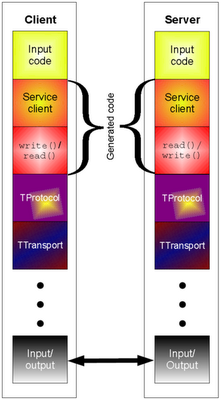使用Java快速入門Thrift
阿新 • • 發佈:2019-02-17
Apache Thrift是一個facebook建立的RPC框架,現在是一個Apache的頂級專案。Thrift允許通過一個跨語言的定義檔案的方式定義資料型別和服務介面,這個檔案作為RPC客戶端和伺服器通訊的標準,你也可以去看看Thrift的白皮書瞭解更多資訊。
根據Apache Thrift的官方站點的描述,Thrift是一個:
software framework, for scalable cross-language services development, combines a software stack with a code generation engine to build services that work efficiently and seamlessly between C++, Java, Python, PHP, Ruby, Erlang, Perl, Haskell, C#, Cocoa, JavaScript, Node.js, Smalltalk, OCaml and Delphi and other languages.

安裝Thrift比較的煩,但是在Windows下官方編譯了一個thrift.exe,下載安裝就行了。
寫 Thrift定義檔案(.thrift file)
如果你之前有接觸過這個東西的話,寫定義檔案非常的簡單。但這裡可以參考官方的教程快速開始。
示例定義檔案(add.thrift)
namespace java com.eviac.blog.samples.thrift.server // defines the namespace typedef i32 int //typedefs to get convenient names for your types service AdditionService { // defines the service to add two numbers intadd(1:intn1, 2:intn2), //defines a method }
編譯Thrift定義檔案
下面的命令編譯.thrift檔案
thrift --gen <language> <Thrift filename>
對於我的例子來講,命令是:
thrift --gen java add.thrift
在執行完程式碼後,在gen-java目錄下你會發現構建RPC伺服器和客戶端有用的原始碼。在我的例子中我將建立一個叫做AddtionService.java的java檔案。
寫一個 service handler
Service handler 類必須實現 AdditionService.Iface介面。
示例Service handler(AdditionServiceHandler.java)
package com.eviac.blog.samples.thrift.server;
import org.apache.thrift.TException;
public class AdditionServiceHandler implements AdditionService.Iface {
@Override
publicint add(intn1, intn2) throws TException {
returnn1 + n2;
}
}寫一個簡單的伺服器
下面的示例程式碼是一個簡單的Thrift伺服器。可以看到下面的程式碼中有一段是註釋了的,可以去掉註釋來啟用多執行緒伺服器。
示例伺服器(MyServer.java)
package com.eviac.blog.samples.thrift.server;
import org.apache.thrift.transport.TServerSocket;
import org.apache.thrift.transport.TServerTransport;
import org.apache.thrift.server.TServer;
import org.apache.thrift.server.TServer.Args;
import org.apache.thrift.server.TSimpleServer;
public class MyServer {
public static void StartsimpleServer(AdditionService.Processor<AdditionServiceHandler> processor) {
try{
TServerTransport serverTransport = new TServerSocket(9090);
TServer server = new TSimpleServer(
newArgs(serverTransport).processor(processor));
// Use this for a multithreaded server
// TServer server = new TThreadPoolServer(new
// TThreadPoolServer.Args(serverTransport).processor(processor));
System.out.println("Starting the simple server...");
server.serve();
}catch(Exception e) {
e.printStackTrace();
}
}
public static void main(String[] args) {
StartsimpleServer(new AdditionService.Processor<AdditionServiceHandler>(new AdditionServiceHandler()));
}
}寫一個客戶端
下面的例子是一個使用Java寫的客戶端短使用AdditionService的服務。
package com.eviac.blog.samples.thrift.client;
import org.apache.thrift.TException;
import org.apache.thrift.protocol.TBinaryProtocol;
import org.apache.thrift.protocol.TProtocol;
import org.apache.thrift.transport.TSocket;
import org.apache.thrift.transport.TTransport;
import org.apache.thrift.transport.TTransportException;
public class AdditionClient {
public static void main(String[] args) {
try{
TTransport transport;
transport = new TSocket("localhost",9090);
transport.open();
TProtocol protocol = new TBinaryProtocol(transport);
AdditionService.Client client = new AdditionService.Client(protocol);
System.out.println(client.add(100,200));
transport.close();
}catch(TTransportException e) {
e.printStackTrace();
}catch(TException x) {
x.printStackTrace();
}
}
}執行服務端程式碼(MyServer.java)將會看到下面的輸出。
Starting the simple server...
然後執行客戶端程式碼(AdditionClient.java),將會看到如下輸出。
300
